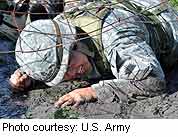

Military service members who undergo brain imaging soon after suffering a traumatic brain injury (TBI) may get better treatment more promptly, a new study suggests.
The researchers found that MRI can help doctors detect microbleeding on the brain, which can sometimes trigger serious secondary health conditions, like brain swelling or stroke.
“TBI is a large problem for our military service members and their families,” said study leader Dr. Gerard Riedy, chief of neuroimaging at the National Intrepid Center of Excellence at the Walter Reed National Military Medical Center in Bethesda, Md.
“We found that many of those who have served and suffered this type of injury were not imaged until many, many months after injury occurred, thus resulting in lower rates of cerebral microhemorrhage detection, which delays treatment,” he added in a news release from the Radiological Society of North America.
In conducting the study, the researchers used special MRI scans to examine 603 military personnel diagnosed with traumatic brain injury. The imaging technique they used provides greater visibility of blood and is much more sensitive to bleeding than conventional MRI.
The median time that lapsed from when the participants were injured to their MRI was 856 days. The patients were divided into two groups: those who were injured within three months and those whose injury occurred at least three months to more than a year earlier.
Of the 603 military service members who participated in the study, 7 percent were found to have at least one occurrence of microbleeding on the brain, according to the study, which was published online Sept. 15 in Radiology.
Those who underwent an MRI more than a year after they were hurt had a lower rate of brain microbleeding than those scanned within 12 months following a traumatic brain injury. Brain bleeding was detected in 24 percent of those who had an MRI three months after their injury. In contrast, bleeding was found in only 5.2 percent of the patients imaged a year after their injury.
The researchers explained that bleeding becomes harder to diagnose with time as changes occur in iron deposits in the brain.
“Early characterization of cerebral microhemorrhages may help to explain clinical symptoms of acute TBI and identify the severity of brain damage,” Riedy said. “We believe that having access to MRI in the field would facilitate early detection of TBI, thus providing timely treatment.”
About 1.7 million people suffer traumatic brain injuries each year, according to the U.S. Centers for Disease Control and Prevention. Up to 23 percent of military service members serving overseas in Afghanistan and Iraq also sustain this type of injury.
More information
The U.S. National Institute of Neurological Disorders and Stroke provides more on traumatic brain injury.
Source: HealthDay
Copyright © 2024 HealthDay. All rights reserved.

Leave a Reply